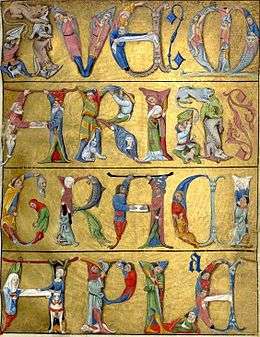Ave Maria (Biebl)
Ave Maria by Franz Biebl is a motet composed for double choir, a large four-part choir and a three-part choir which can be performed by soloists. It is a setting of part of the Latin liturgical Angelus prayer, which contains the Ave Maria (Hail Mary) as a refrain. The composition was originally written for men's chorus, but the composer wrote arrangements for mixed choir and women's choir. The work and arrangements were published by Wildt's Musikverlag, first in 1964. The piece first became famous when a U.S. group, the Cornell University Glee Club, included it in their Christmas programs, and more famous when the Chanticleer ensemble made it part of their regular repertoire. It was published in the U.S. by Hinshaw and became one of the publisher's best-selling items.
| Ave Maria | |
|---|---|
| Sacred motet by Franz Biebl | |
 Ave Maria from the Heures de Charles d'Angoulême | |
| Key | B-flat major |
| Text | Angelus |
| Language | Latin |
| Published | 1964 |
| Scoring | Double choir (different arrangements) |
History
Biebl was the organist and choir master of a parish in Fürstenfeldbruck, Bavaria, and of a men's chorus there, for which he composed many works and arrangements. He composed Ave Maria sometime before May 1959, when it was performed in a Maiandacht.[1]:14 It was written for men's chorus, and this version was published by Wildt's Musikverlag in 1964.[1]:15–16 However, it was not performed often, since German men's choirs generally did not perform religious music.[1]:16 On a 1970 tour in Germany, the Cornell University Glee Club from the U.S. met Biebl, who was working for the broadcaster Bayerischer Rundfunk and responsible for choral music. Conductor Thomas A. Sokol received several of Biebl's compositions, which he performed in the U.S.[2] When the Chanticleer vocal ensemble made Ave Maria part of their repertoire, it gained popularity.[1]:2 They first performed it in a charity event on 4 December 1989 at the City Hall in San Francisco, then presented it in subsequent Christmas concerts and included it in their tour program the next year.[1]:33 The work is now considered a standard of the choral repertoire.[1]:ii
Biebl wrote arrangements for mixed choirs in 1985[1]:16 and 1998.[1]:17 It was published in the U.S. by Hinshaw Music[3] in 1992,[1]:2 and became one of the publisher's best-selling items, the four versions selling over 670,000 copies between 1992 and 2016.[1]:40
Text
The text is the beginning of the Latin Catholic liturgical Angelus prayer, three verses based on biblical sources, with the Ave Maria as a refrain. In Biebl's setting, the Ave Maria refrain contains only the first half of the Ave Maria prayer, the benediction of Mary and the fruit of her womb, Jesus. The second half, praying for Mary's intercession, is delivered as a conclusion, deviating slightly from the liturgical text by addressing Mary as Holy Mother twice, asking firstly for intercession with "us sinners", and secondly for "in the hour of our death", while the Ave Maria prayer combines both requests in one. The prayer is closed by Amen.[4]
|
Latin Angelus Domini nuntiavit Mariae |
English The Angel of the Lord announced to Mary |
Music
The original composition was in D major for men's choir, with a four-part choir TTBB and a three-part choir TTB. When it was published, it was transposed to B-flat major.[1]:15–16 The verses from the Angelus are recited by one voice in chant-like fashion in free tempo.[4] The refrain is sung by the choirs, with the four-part choir beginning and the three-part choir following one measure later, in an alternating pattern kept throughout the piece. The final choral setting, Sancta Maria, is intensified in vocal range and dynamics, concluding in Amen set in a similar pattern.[4] The choral singing is marked once at the beginning "Ruhig fließend" (Calmly flowing), in common time. The choirs operate in different rhythm: the four-part choir begins with three quarter-notes towards a long note in the second measure, while the three-part choir begins on the first beat in measure two.[4]
Biebl wrote arrangements for SATB/SAT, TTBB/SSA,[1]:16 and SSAA/SSA choirs.[1]:17 The first narration from the Angelus is meant to be sung by basses, the second by second tenors, and the third by first tenors. The three-part choir can be sung by solo voices.[4]
The San Francisco Renegades[5][6] and the Phantom Regiment Drum and Bugle Corps[7] arranged the work for brass band, among others.
References
- Oltman, Matthew (July 2017). The Iconic One-Hit Wonder: The History and Reception of Franz Biebl's Ave Maria. Retrieved 22 March 2018.
- Michael Slon, Songs from the Hill – A History of the Cornell University Glee Club.
- "Ave Maria". Hinshaw Music. Chapel Hill, North Carolina. Retrieved 9 December 2019.
- Ave Maria (Angelus Domini) (in German). Dortmund: Wildt's Musikverlag. 1964.
- 2003 Renegades VHS. renegades.org. 2003. Retrieved 11 December 2019.
- More California Drum Corps Events. worldofpageantry.com. 11 June 2003. Retrieved 11 December 2019.
- Blair, Tom; Clark, Jeff; Drum and Bugle Corps; Santa Clara Vanguard (2006), Drum Corps International 2006 world championships, August 8-12, Madison, Wisconsin. Volume 1, Drum Corps International, OCLC 150686042, retrieved 2019-12-11
External links
- Outstanding Features of Franz Biebl's Works at the Wayback Machine (archived July 16, 2011)
- Index of Biebl's principal works (Archive from 16 July 2011)
- The Fascinating Backstory on Franz Biebl's "Ave Maria" behind-the-music.com
- Ave Maria-Franz Biebl- Chanticleer on YouTube